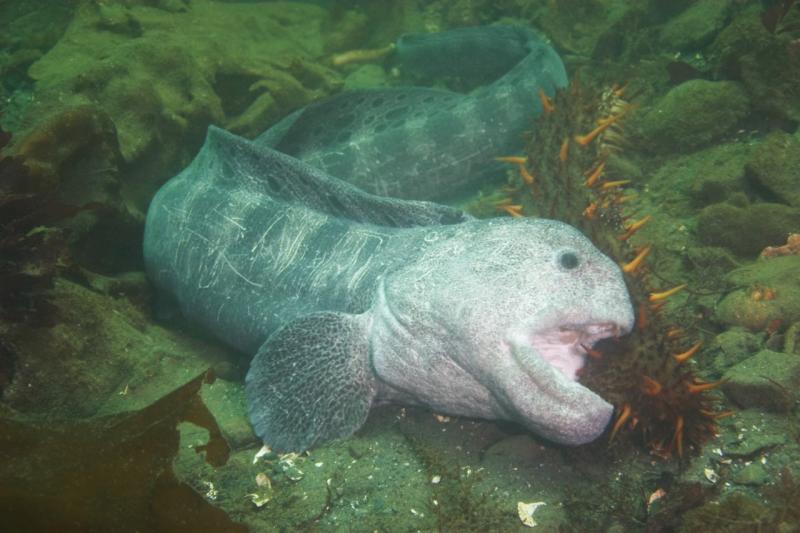

Wolf eels are present in the Northern Pacific and the Sea of Japan. Though there is no exact estimation of the number of wolf eels present in the world, their population can be considered to be stable as they are not the common target of fisheries. How many wolf eels are there in the world? They are in the family Anarhichadidae and have the scientific name Anarrhichthys ocellatus.

Wolf eels belong to the class Actinopterygii. What class of animal does a wolf eel belong to? These animals are found in the Northern Pacific Ocean. These fish have a long life and can live for more than 20 years in captivity.įor more relatable content, check out these lamprey facts and lungfish facts for kids.įamily Anarhichadidae Wolf Eel Interesting Facts What type of animal is a wolf eel?Ī wolf eel is basically a fish, even though its name suggests otherwise. Juvenile wolf eels have more predators, including the kelp greenling and rockfish, as they cannot protect themselves adequately.

Some of the common predators who prey on wolf eels are harbor seals, sharks, and bigger fish. They are said to be quite voracious feeders. These fish make use of their strong teeth to feed on mussels, sea urchins, crabs, and more. They look quite scary, but in reality, they hardly ever show aggression unless provoked. Wolf eels have a peculiar appearance with a prominent head, sharp teeth, and a slender body. Wolf eels mainly occupy reefs, rock pilings, and dens where they live with their mate, usually for life. They can be found in the North Pacific, along the coasts of islands near Alaska, along the coast of California, and in the Sea of Japan. Wolf eels are the only species under the Anarrhichthys genus. They are a part of the Anarhichadidae family, which is also known as the wolffish family. While these slower-moving, curious fish are always an exciting sight for divers, it is important to respect the animal’s space.Ĭheck out below to see the amazing transition in colouring between juvenile and adult wolf eels in this Hakai Wild video.The wolf eel (Anarrhichthys ocellatus) is a species of fish with an eel-like appearance. They are also often accidentally caught by fishers. Wolf eels are not at risk in British Columbia, but they still face threats like pollution, which can negatively affect the health of their environment (like kelp forests) and decrease prey populations. Other wolf eels and octopuses are often looking for crevices and holes to have their dens, so there can be fierce competition and battles for the best spots ( video). When wolf eels reach sexual maturity and find a mate, the two must find their perfect den to spend the rest of their life. Photo: Jackie HilderingĪn unusual behaviour of these ancient-looking fish is that they mate for life! Monogamy isn’t common practice in the ocean, with plenty of fish in the sea and all, but wolf eels make it work.

Above is the upper jaw of a wolf eel with bony, tooth-like projections. This diverse diet helps sustain the wolf eel’s enormous (wolf-like) appetite. Wolf eels have teeth on the roof of their mouths to be able to crunch even the toughest of shells. This is true, but along with fish, wolf eels use their large teeth and massive jaws to prey on hard-shelled invertebrates like mussels, crabs and even spiny sea urchins. The large teeth and jaws of the wolf eel may have you thinking they would be successful fish predators. A wolf eel swims into a hole in the rocks using its long body. The body shape and movement of a wolf eel is similar to another eel-like fish we discussed a few weeks ago, gunnels. This body shape lets them slide into dark crevices and move stealthily along the seafloor. Wolf eels still have pectoral fins like most fishes, but the rest of their elongate body looks very eel-like. And yes, I said fish! Even though their common name suggests that they are an eel, wolf eels ( Anarrhichthys ocellatus) are part of the wolffish family and not true eels. While their bulbous heads and large, toothy mouths can look frightening, these fish are generally slow-moving and sedentary. Well, maybe not to their prey, but with divers, they tend to shy away in their caves and peek out. Hidden in the darkness of the deep, wolf eels are not as dangerous as they look according to The Marine Detective. Sea Discovery: Wolf eels, the not so terrifying “wolf-ish” fish


 0 kommentar(er)
0 kommentar(er)
